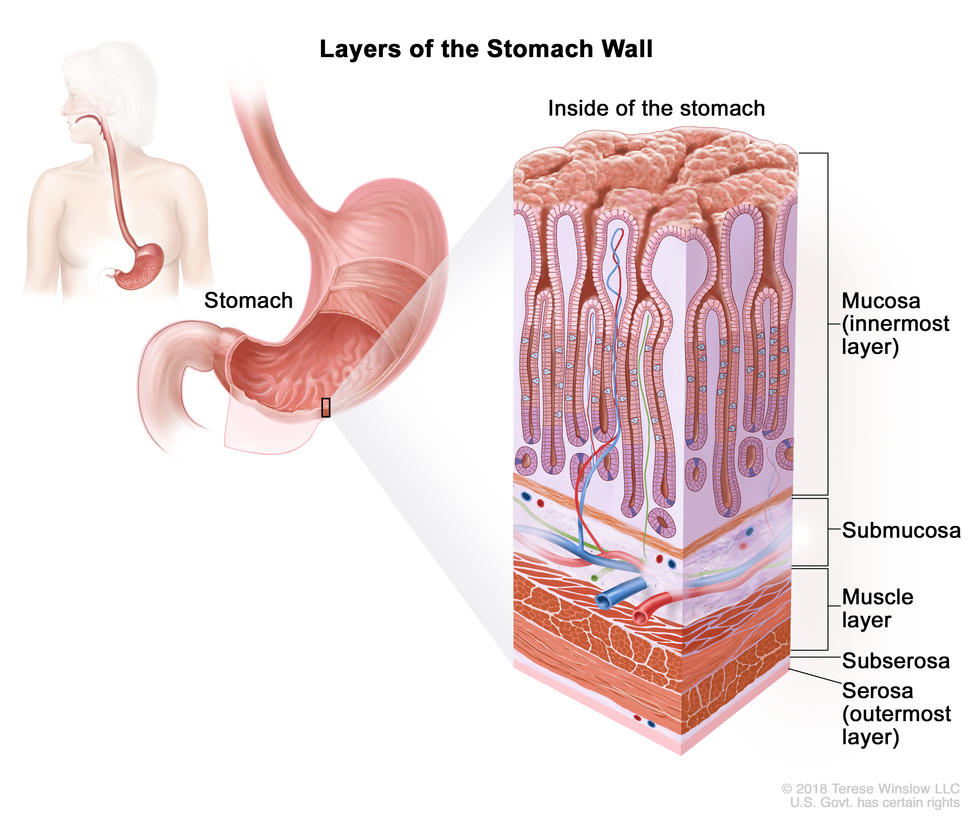Layers of the stomach wall
The stomach wall is made up of five layers of tissue and muscle. Knowing about these layers can help you understand the stage of your cancer.
- The mucosa is the innermost layer of the stomach wall. It is made of both epithelial cells and glandular cells. The glandular cells make mucus to protect the stomach lining and digestive juices to help break down food. Most stomach cancers start in glandular cells of the mucosa. Cancers that start in glandular cells are adenocarcinomas.
- The submucosa is the layer of connective tissue between the mucosa and the muscle layer. It contains blood vessels, lymph vessels, and nerve cells.
- The muscle layer is the next layer. The muscle layer helps the stomach mix food with digestive juices and move it into the small intestine, where nutrients are absorbed.
- The subserosa is a thin layer of connective tissue between the muscle layer and the serosa.
- The serosa is the outermost layer of the stomach wall.
Stomach cancers become more advanced as they spread from the mucosa to the outer layers.
To learn more about the stomach, see What Is Stomach Cancer?
Stage 0 (carcinoma in situ) of the stomach
Stage 0 refers to carcinoma in situ. This means that abnormal cells are found in the mucosa. These abnormal cells may become cancer and spread into nearby normal tissue.
Learn about treatment of stage 0 (carcinoma in situ) of the stomach.
Stage I (also called stage 1) stomach cancer
Stage I is divided into stages IA and IB.
- In stage IA,
- cancer has formed in the mucosa and may have spread to the submucosa.
- In stage IB,
- cancer has formed in the mucosa and may have spread to the submucosa and has spread to 1 or 2 nearby lymph nodes; or
- cancer has formed in the mucosa and has spread to the muscle layer.
Stage II (also called stage 2) stomach cancer
Stage II is divided into stages IIA and IIB.
- In stage IIA,
- cancer may have spread to the submucosa and has spread to 3 to 6 nearby lymph nodes; or
- cancer has spread to the muscle layer and to 1 or 2 nearby lymph nodes; or
- cancer has spread to the subserosa.
- In stage IIB,
- cancer may have spread to the submucosa and has spread to 7 to 15 nearby lymph nodes; or
- cancer has spread to the muscle layer and to 3 to 6 nearby lymph nodes; or
- cancer has spread to the subserosa and to 1 or 2 nearby lymph nodes; or
- cancer has spread to the serosa.
Stage III (also called stage 3) stomach cancer
Stage III is divided into stages IIIA, IIIB, and IIIC.
- In stage IIIA,
- cancer has spread to the muscle layer and to 7 to 15 nearby lymph nodes; or
- cancer has spread to the subserosa and to 3 to 6 nearby lymph nodes; or
- cancer has spread to the serosa and to 1 to 6 nearby lymph nodes; or
- cancer has spread to nearby organs, such as the spleen, colon, liver, diaphragm, pancreas, abdomen wall, adrenal gland, kidney, or small intestine, or to the back of the abdomen.
- In stage IIIB,
- cancer may have spread to the submucosa or to the muscle layer and has spread to 16 or more nearby lymph nodes; or
- cancer has spread to the subserosa or to the serosa and has spread to 7 to 15 nearby lymph nodes; or
- cancer has spread to nearby organs, such as the spleen, colon, liver, diaphragm, pancreas, abdomen wall, adrenal gland, kidney, or small intestine, or to the back of the abdomen. Cancer has also spread to 1 to 6 nearby lymph nodes.
- In stage IIIC,
- cancer has spread to the subserosa or to the serosa, and to 16 or more nearby lymph nodes; or
- cancer has spread to nearby organs, such as the spleen, colon, liver, diaphragm, pancreas, abdomen wall, adrenal gland, kidney, or small intestine, or to the back of the abdomen. Cancer also has spread to 7 or more nearby lymph nodes.
Stage IV (also called stage 4) stomach cancer
In stage IV, cancer has spread to other parts of the body, such as the lungs, liver, distant lymph nodes, and the tissue that lines the abdomen wall.
Stage IV stomach cancer is also called metastatic stomach cancer. Metastatic cancer happens when cancer cells travel through the lymphatic system or blood and form tumors in other parts of the body. The metastatic tumor is the same type of cancer as the primary tumor. For example, if stomach cancer spreads to the lung, the cancer cells in the lung are actually stomach cancer cells. The disease is called metastatic stomach cancer, not lung cancer. Learn more in Metastatic Cancer: When Cancer Spreads.
Recurrent stomach cancer
Recurrent stomach cancer is cancer that has recurred (come back) after it has been treated. Stomach cancer may come back in the stomach, lymph nodes, or other parts of the body, such as the liver, lung, or bone. Tests will be done to help determine where the cancer has returned in your body. The type of treatment that you have for recurrent stomach cancer will depend on where it has come back.
Learn more in Recurrent Cancer: When Cancer Comes Back. Information to help you cope and talk with your health care team can be found in Coping with Stomach Cancer.
